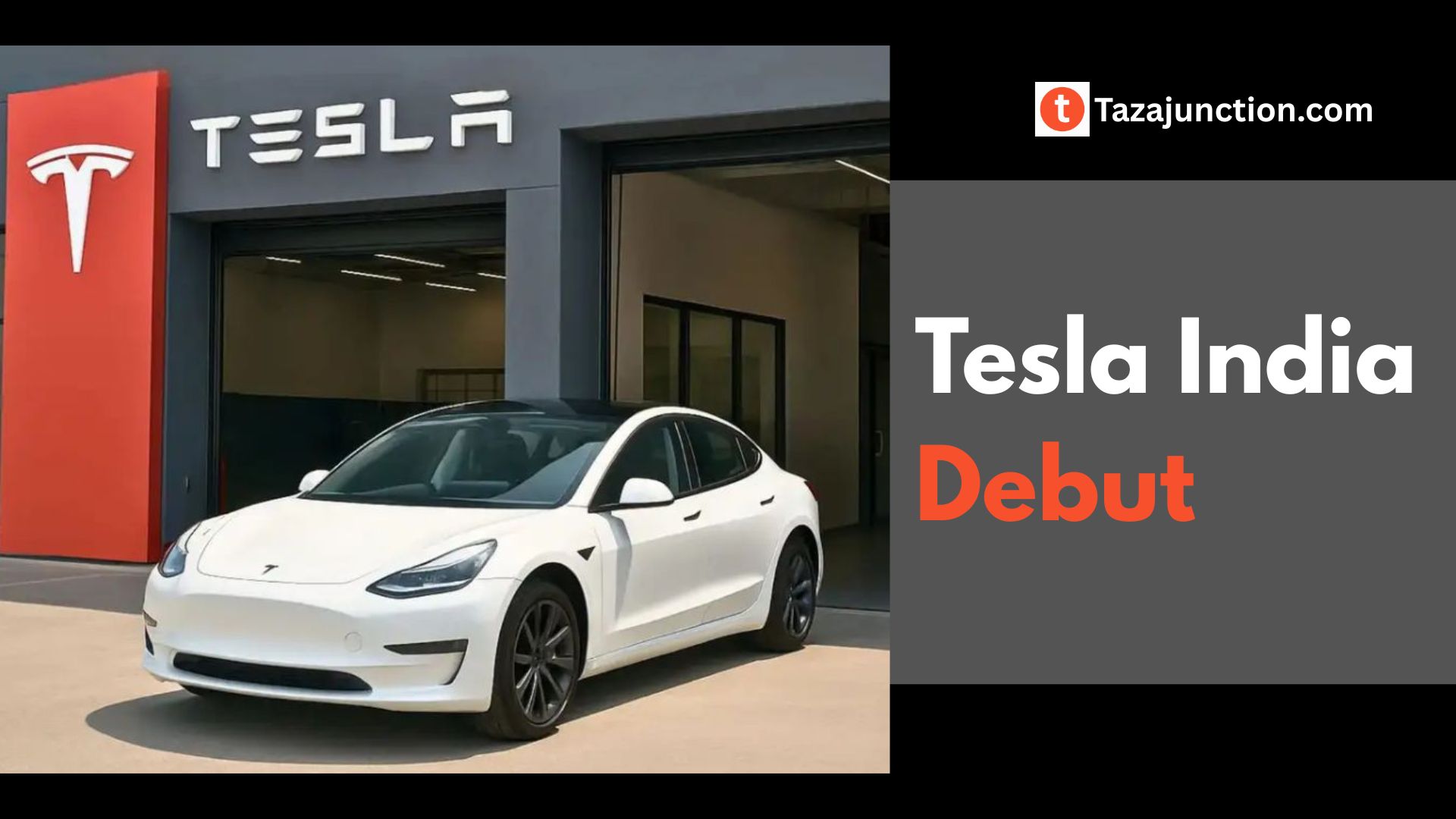Global electric vehicle (EV) giant Tesla Inc. officially launched its operations in India with the opening of its first showroom in Mumbai of Tesla India, marking a major milestone in the country’s fast-evolving electric mobility space.
The “Experience Centre,” located in the city’s upscale Bandra-Kurla Complex (BKC), symbolizes Tesla’s long-anticipated entry into one of the world’s largest automobile markets.
The event, attended by Maharashtra Chief Minister Devendra Fadnavis, Tesla executives, and various state dignitaries, was seen as a significant endorsement of India’s commitment to transitioning toward clean transportation.
Table of Contents
A Glimpse Into the Showroom of Tesla India
Tesla new Experience Centre spans approximately 4,000 square feet and features its signature minimalistic, tech-forward design. The space allows prospective customers to interact with Tesla’s cutting-edge features—such as Autopilot, infotainment systems, and real-time software updates—through digital displays and demo vehicles.
The first showroom highlights the Tesla Model Y, with other models like the Model 3 expected to follow shortly. Touchscreen kiosks, immersive vehicle customization tools, and expert consultations are also part of the showroom experience.
According to sources close to Tesla India, over 30 employees have already been onboarded to manage sales, service, logistics, and vehicle operations at the Mumbai location.
Model Y Launch: Specifications and Pricing

The Mumbai launch coincided with the formal unveiling of the Model Y for the Indian market. Two variants were introduced:
- Model Y Rear-Wheel Drive (RWD): Offers a range of around 500–574 kilometers on a full charge.
- Model Y Long-Range All-Wheel Drive (AWD): Delivers a range of up to 622 kilometers and a faster 0–100 km/h acceleration.
However, pricing has drawn mixed reactions. The Model of Tesla India Y RWD starts at ₹59.9 lakh, while the AWD variant is priced at approximately ₹67.9 lakh (ex-showroom). These prices include steep import duties—up to 100%—since the vehicles are currently being imported from Tesla’s Shanghai Gigafactory in China.
Industry analysts point out that these prices may limit Tesla’s initial customer base in India to premium buyers, given that comparable EVs from domestic manufacturers are significantly more affordable.
Charging Infrastructure in the Pipeline
Understanding the critical role of EV infrastructure, Tesla has already begun deploying its proprietary Supercharger network in Mumbai. The company aims to establish four charging hubs across the city, including locations in Lower Parel, BKC, Thane, and Navi Mumbai.
Each site will be equipped with Superchargers capable of delivering up to 267 km of range in 15 minutes, as well as destination chargers suitable for overnight or extended charging sessions.
The plan includes setting up a total of 16 Superchargers and 16 destination chargers in the first phase, with further expansion into cities like Delhi, Bengaluru, and Hyderabad under consideration.
Political and Industry Reactions
Chief Minister Fadnavis, speaking at the launch, hailed the move as a landmark moment for India’s mobility landscape. He called Mumbai and Maharashtra the “right city and right state” for Tesla’s debut, citing strong EV policies, infrastructure, and innovation ecosystems.
He recalled his first experience with a Tesla in San Francisco in 2015 and expressed pride that the global EV leader is finally setting foot in India. He also indicated that the state is open to supporting Tesla with land, incentives, and partnerships should the company choose to establish local manufacturing or R&D facilities.
Leaders from India’s automotive sector, including executives from Tata Motors, Mahindra, and Hyundai, welcomed Tesla’s entry, viewing it as a step forward for India’s position in the global EV market. Mahindra Group Chairman Anand Mahindra tweeted a welcoming message, encouraging healthy competition that drives innovation.
Market Position and Consumer Response
India’s EV market is still in its early stages, with electric vehicles accounting for only around 2–4% of total car sales. However, the luxury EV segment is even smaller, which means Tesla is targeting a niche market with its current offerings.
Despite this, brand recognition and aspirational value are expected to work in Tesla’s favor. Early bookings for the Model Y have already begun, with first deliveries anticipated by late Q3 2025.
Tesla has positioned itself as a lifestyle and technology brand, and it is expected to build awareness through test drives, word-of-mouth, and digital engagement. Given the premium pricing, analysts believe Tesla will aim to solidify its presence in major metro areas before expanding to smaller cities.
Roadblocks and Challenges
While the launch is being celebrated, Tesla still faces several challenges in India:
1. Import Tariffs
India levies some of the highest import duties in the world on electric vehicles—up to 100% for cars above $40,000. This significantly inflates prices and makes Tesla less competitive compared to local EV options.
2. Limited Infrastructure
Although Tesla is building its own Supercharger network, the broader public EV charging infrastructure in India remains underdeveloped, especially outside tier-1 cities.
3. Regulatory Hurdles
Autonomous driving features like Tesla’s Full Self-Driving (FSD) software are still not approved under Indian traffic laws. Additionally, the complexity of Indian road conditions makes it unlikely that autonomous functions will be fully usable anytime soon.
4. Service and Support
As a new player, Tesla must build trust among Indian consumers regarding after-sales service, spare parts availability, and insurance partnerships.
What’s Next for Tesla India?
Tesla has also registered offices in Bengaluru and operates an engineering hub in Pune, signaling longer-term plans for a broader Indian footprint.
Discussions are ongoing between Tesla and central government officials regarding local manufacturing, which could dramatically reduce vehicle prices and make the brand more competitive in India.
If Tesla sets up an Indian Gigafactory, it could leverage the country’s large engineering workforce, lower manufacturing costs, and strategic location in Asia. However, this depends on a mutual agreement around tariff reductions and policy incentives.
In the near term, Tesla India is expected to expand its Model lineup, introduce software upgrades, and host experiential events across India. A second showroom is rumored to be in development in New Delhi, followed by one in Bengaluru.
Conclusion
Tesla’s entry into India—starting with its flagship showroom in Mumbai—represents a pivotal moment for both the company and the Indian electric vehicle market. While the price point may limit immediate mass adoption, the symbolic and strategic value of Tesla’s presence cannot be overstated.
The company’s commitment to infrastructure, digital innovation, and brand-driven engagement could reshape how Indians view electric mobility. For now, the Mumbai showroom offers consumers a first-hand look at the future of driving—a future that’s electric, connected, and increasingly, Indian.

